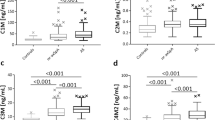Summary
Objective: The acceptance of fibromyalgia as a disease entity and its definitive diagnosis have been hampered by a dearth of knowledge concerning the underlying pathophysiology of this disease and the lack of specific biochemical markers applicable to its diagnosis. To determine whether abnormal collagen metabolism is a characteristic of fibromyalgia, we have analyzed collagen metabolites in the urine and serum of patients with fibromyalgia. Methods: The diagnosis of fibromyalgia was made according to the American College of Rheumatology criteria. Urine and serum were collected under standardized conditions from 39 patients and 55 age- and sex-matched controls. Pyridinoline (Pyd) and deoxypyridinoline (Dpyd), which represent products of lysyl oxidase-mediated cross-linking in collagen and are indicators of connective tissue and bone degradation, respectively, were analyzed by ion-paired and gradient HPLC method with fluorescence detection (HPLC). Levels of hydroxypyroline (Hyp), a collagen turnover marker, were also measured. The findings were related to creatinine levels and the Pyd/Dpyd ratio determined. Results. The Pyd/Dpyd ratios in the urine and serum and the Hyp in the urine were significantly lower in patients with fibromyalgia than in healthy controls. Conclusion: Decreased levels of collagen cross-linking may contribute to remodeling of the extracellular matrix and collagen deposition around the nerve fibers in fibromyalgia and contribute to the lower pain threshold at the tender points. Analysis of altered collagen metabolism either by histologic examination on biopsy or, preferably, by HPLC analysis of collagen metabolites in urine or serum may aid to understand more about the pathogenesis of fibromyalgia.
Zusammenfassung
Einleitung: Das Fehlen von Daten zur Pathophysiologie der Fibromyalgie sowie von kranheitsspezifischen Laborparametern bereitet Schwierigkeiten, die Erkrankung als Entität anzuerkennen. Auf der Suche nach charakteristischen Merkmalen der Fibromyalgie bestimmten wir die Konzentration der Kollagen-Crosslinks im Urin und im Serum der Patienten. Methoden: Die Patienten mit Fibromyalgie wurden entsprechend den American College of Rheumatology-Klassifikationskriterien in die Studie eingeschlossen. Von 39 Fibromyalgie-Patienten und von 55 gesunden Kontrollpersonen wurden unter standardisierten Bedingungen Urin- und Serumproben genommen. Pyridinolin (Pyd) und Desoxypyridinolin (Dpyd), lysyloxidasevermittelte Produkte und bindegewebs- und knochenumbaudeterminierende Marker des Kollagenstoffwechsels, wurden mittels HPLC detektiert. Hydroxyprolinspiegel (Hyp), ein Marker des Kollagen-Turnover, wurden ebenfalls gemessen. Die Ergebnisse wurden auf den Kreatininspiegel normiert und der Pyd/Dpyd-Quotient gebildet. Ergebnisse: Die Pyd/Dpyd-Ratio in Urin und Serum und der Hyp-Spiegel im Urin waren bei den Fibromyalgie-Patienten im Vergleich zu den Kontrollpersonen signifikant vermindert. Schlußfolgerung: Die gefundenen, verminderten Kollagen-Crosslinks-Spiegel sind möglicherweise auf ein Remodelling der extrazellulären Matrix und der Ausbildung von Kollagenablagerungen um preterminale Nervenfasern in der Haut von Fibromyalgie-Patienten (abgesenkte Schmerzschwelle?) zurückzuführen. Die Analyse eines gestörten Kollagenmetabolismus durch histologische Untersuchungen oder, besser, durch HPLC-Analyse der Kollagen-Crosslinks im Urin oder Serum kann möglicherweise zum weiteren Verständnis der Pathogenese der Fibromyalgie beitragen.
Similar content being viewed by others
Author information
Authors and Affiliations
Rights and permissions
About this article
Cite this article
Sprott, H., Müller, A. & Heine, H. Collagen cross-links in fibromyalgia syndrome. Z Rheumatol 57 (Suppl 2), S52–S55 (1998). https://doi.org/10.1007/s003930050235
Issue Date:
DOI: https://doi.org/10.1007/s003930050235




